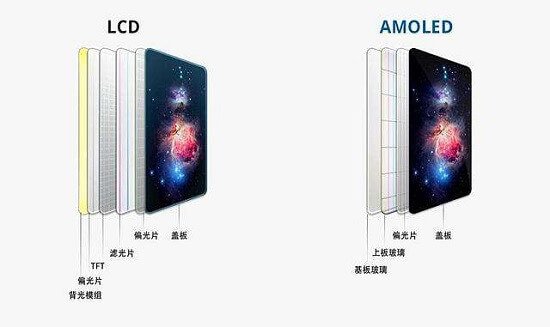Currently, in the mobile phone industry, the mainstream mobile phone screen materials are LCD and AMOLED. Perhaps consumers can tell some basic characteristics of these two screens. For example, AMOLED screens have a wide color gamut and LCD screens are more mature. From a technical point of view, What is the difference between AMOLED and LCD screens?
What is AMOLED?
AMOLED stands for Active Matrix Organic Light-Emitting Diode, and the core is still LED. Although LEDs are also common in daily life, in the screen, the size of each LED is very small and is divided into three sub-pixels of red, green, and blue, and then through the combination of different colors, and the arrangement of sub-pixels Will directly affect the entire display effect. The O in AMOLED stands for Organic, that is, “organic”, that is, a series of organic thin-film materials are used between the positive and negative electrodes to achieve the purpose of light emission.
The advantage of the OLED screen is the high degree of controllability of the pixels, each pixel can be controlled independently, so as to achieve higher contrast. In addition, turning off unnecessary pixels while displaying the screen can also reduce power consumption. At the same time, because the OLED structure is relatively simple, the light transmittance is also better, which is conducive to achieving higher brightness and wider viewing angles.
Compared with LCD, OLED screens can be made very thin, very suitable for mobile devices such as mobile phones. In addition, due to the lack of a hard backlight layer and the maturity of flexible plastic substrates, OLEDs also have great advantages on flexible screens, making future device shapes appear infinitely possible.
What is LCD?
The full name of LCD is Liquid Crystal Display, and the way it emits light is very different from AMOLED screens. Unlike AMOLED screen pixels that can emit light independently, all pixels of an LCD screen need to rely on a unified backlight layer to emit light. Of course, for some large-size LCD screens used on TVs, multiple light sources may also be equipped to reduce power consumption.
Strictly speaking, there is no wavelength corresponding to white light, and white light is just a mixed light of multiple colors. For this reason, LCD liquid crystal screens need to produce white by the combination of backlight and phosphor, the most commonly used is the combination of blue backlight and yellow phosphor.
The white light generated by the backlight layer will be the first polarizing layer, which converts the fully polarized light into linearly polarized light, and then passes through the liquid crystal molecule layer. According to different voltages, the liquid crystal molecules exhibit different twisting angles, and then are generated by the red, green and blue filters. Different colors, and finally through the second layer of polarizing layer (perpendicular to the first layer) to achieve the control of light intensity, and finally through the combination of the intensity of three different colors of red, green and blue to achieve different color requirements.
AMOLED and LCD screen comparison
Color Gamut
- AMOLED will have a wider color gamut, and more colors will be displayed, and the displayed pictures will be more delicate.
- In addition, when displaying blue and green, the saturation of AMOLED screens is relatively high. Therefore, in the early days, AMOLED screens were often criticized for inaccurate colors and excessively brilliant colors.
- Compared with AMOLED screens, LCD screens usually overcompensate for red while suppressing green. Although LCD screens have a wider color gamut than AMOLED screens, they are actually closer to the standard RGB color gamut used in video and image editing.
Color Accuracy
- Judging from the test data, the current color accuracy of AMOLED screens is already very good, especially when it is displaying white, while LCD screens are usually a little bluish or greenish. Of course, considering that LCD screens usually use blue light backlights, this result is not unexpected.
- LCD does not have an advantage in weight. Due to the use of a backlight layer, LCD screens have defects such as light leakage and low contrast.
- AMOLED screens have the problem of service life. As the use time increases, color drift may occur, while LCD does not have such a problem.
Which is better, AMOLED or LCD screen?

LCD and AMOLED have their own advantages and disadvantages, and with the continuous optimization of LCD technology and the continuous improvement of AMOLED technology, the gap between LCD and AMOLED on some mid-to-high-end mobile phones has been very small. However, the advantages of OLED screens in terms of power consumption, thickness, and display effect have gradually become prominent. With the reduction of OLED costs, it is more likely to become the future of the display industry. The LCD screen may be slowly squeezed into the low-end market.




